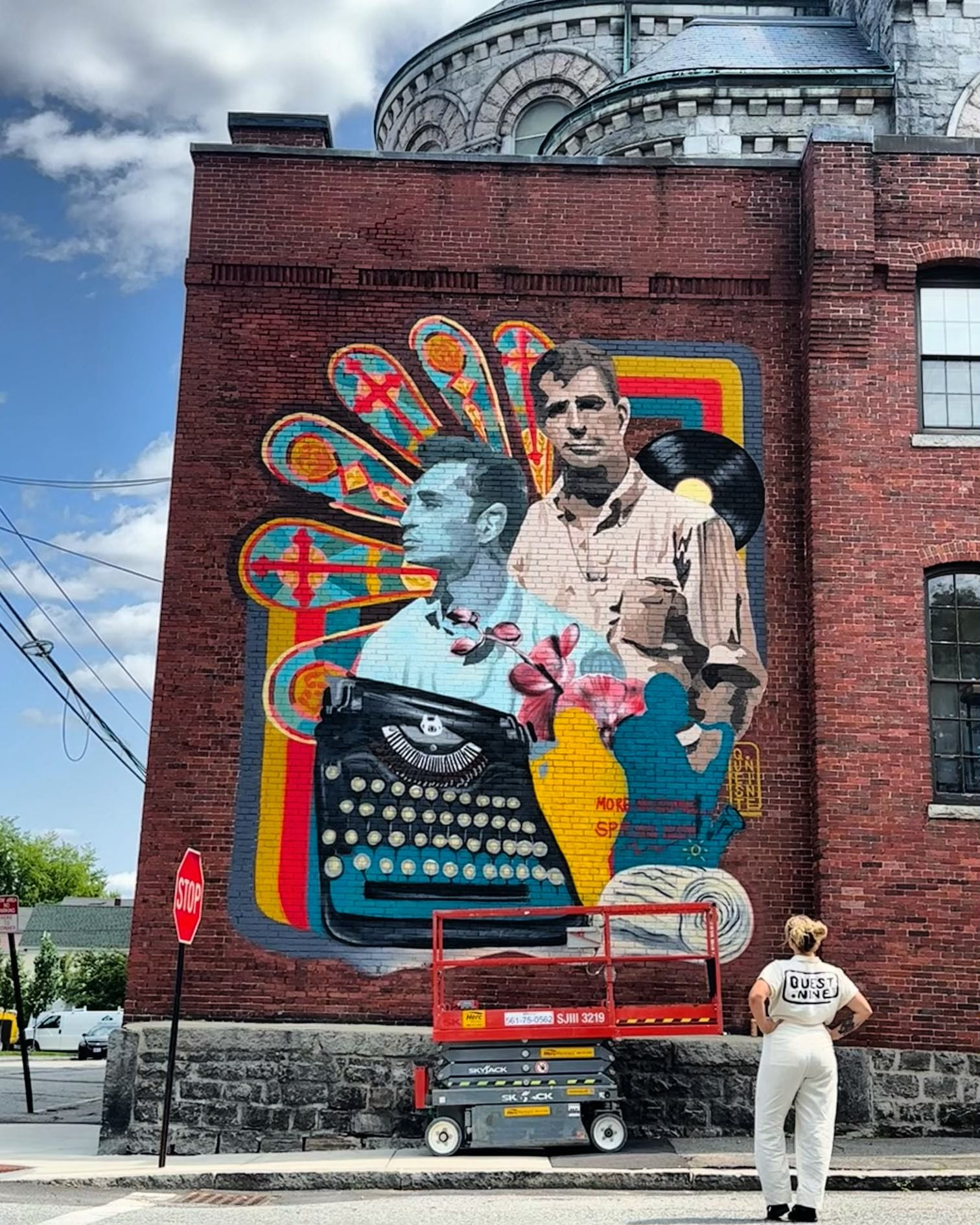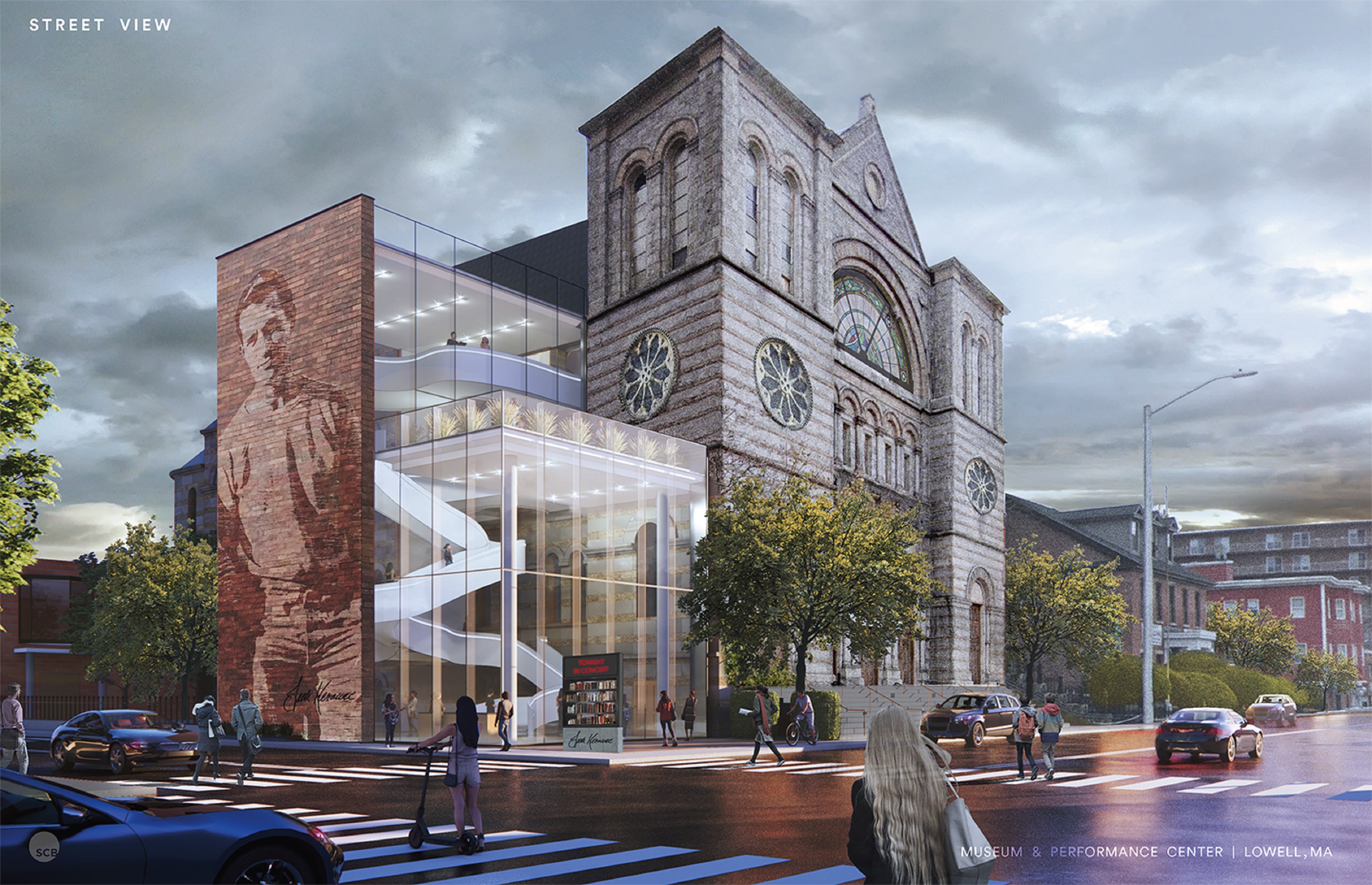“What’s your road, man? – holyboy road, madman road, rainbow road, guppy road, any road.” – Jack Kerouac
For Beat writer Jack Kerouac, author of the legendary novel “On The Road,” the journey began and ends in Lowell.
Jean-Louis “Jack” Kerouac was born on March 12, 1922, into a French-speaking family in Lowell. After his death in Florida in 1969, his funeral was held in Lowell’s St. Jean Baptiste Catholic Church, and he was laid to rest nearby in Edson Cemetery.
Honoring the centennial of the writer’s birth, Kerouac@100 will present an array of public events that captures his lasting influence, legacy and Lowell roots. It all kicks off this weekend. You can view the schedule of free events HERE.
A very special part of the celebration will be “Visions of Kerouac,” a free Lowell National Historical Park exhibit that will open to the public on Friday, March 18 to showcase Kerouac artifacts – much of them from UMass Lowell’s Kerouac archive and his estate – including the original scroll on which he wrote his best-known work, “On The Road,” on loan from Indianapolis Colts owner James Irsay.
Kicking off the celebration will be “Visions of Kerouac,” a free Lowell National Historical Park exhibit that will open to the public on Friday, March 18 to showcase Kerouac artifacts – much of them from UMass Lowell’s Kerouac archive and his estate – including the original scroll on which he wrote his best-known work, “On The Road,” on loan from Indianapolis Colts owner James Irsay.
Writer and photographer John Suiter’s images, depicting Kerouac’s life in Lowell, the Cascade Mountain Range and Mexico, along with photos of Kerouac and his friends taken by Beat poet Allen Ginsberg – some of which will be publicly displayed for the first time, courtesy Ginsberg’s estate – will also figure prominently in the show.
The national park will host the exhibit daily from noon to 5 p.m. through Friday, April 15 in a gallery space inside the Boott Cotton Mills Museum, 115 John St., Lowell. Details on parking and mask requirement for patrons may be found at www.nps.gov/lowe/index.htm.
“The National Park Service is thrilled to be a partner in this exhibit and to be hosting it as part of the Kerouac@100 celebration. Part of the mission of Lowell National Historical Park is preserving and interpreting the stories and heritage of the people of Lowell. That includes Jack Kerouac and how his experiences growing up here influenced his work,” said Lowell National Historical Park Superintendent Julie Galonska.
A Beat generation icon for every generation
Kerouac@100 committee members hail from all corners of North America and include leaders from the city of Lowell, The Jack Kerouac Estate, the Lowell National Historical Park, UMass Lowell, Lowell Celebrates Kerouac, Porter Productions, the Lowell Office of Cultural Affairs, the Pollard Memorial Library, Lowell’s Franco-American Day Committee, and Québec Delégation of Boston.
“Taped together as a scroll so he wouldn’t have to stop, written in a two-and-a-half-week burst that in many ways would change America’s cultural landscape for years to come, one can almost feel the kinetic energy coming from Kerouac's ‘Road’ manuscript. After touring the country, Jim Irsay brings the manuscript that broke a world record when he acquired it, back to Jack’s hometown of Lowell, Massachusetts. We’re so grateful that an audience will be able to see for themselves where the road to Hunter S. Thompson, Bob Dylan, The Doors, and The Grateful Dead began,” said Jim Sampas, literary executor of the Jack Kerouac Estate.
Kerouac@100 planners have other events in store throughout the year, including a youth poetry slam, concerts, lectures and the annual Lowell Celebrates Kerouac! celebration in the fall. Streetlight banners honoring the author will adorn city thoroughfares and public spaces.
“The imagery created for the ‘Visions of Kerouac’ exhibit and Kerouac@100 events nods to the ad-lib style of Kerouac’s own sketches and writing, in modern execution – a trichotomy of superimposed silhouettes inviting the viewer to consider Kerouac’s work from many perspectives; the merge and divide of ideologies,” said Schae Koteles, the graphic designer for the “Visions of Kerouac” exhibit.
Rooted in Lowell
Organizers are hoping a more permanent tribute to Kerouac will also be realized: UMass Lowell English Prof. Michael Millner, who leads the university’s Jack and Stella Kerouac Center for Public Humanities, is the vice president of the new Jack Kerouac Foundation. An early goal of the foundation will be to create a Kerouac museum and performance center in Lowell, potentially in the now-closed St. Jean Baptiste Church.
“The city of Lowell was Kerouac’s primal scene – the culture and collection of people out of which much of his art flows. The Kerouac Center and the Kerouac Foundation are dedicated to celebrating Kerouac’s connection to the city and bringing him to the world,” Millner said.
Millner is especially enthusiastic about the exhibit of the original scroll of “On the Road,” which is based on Kerouac’s cross-country travels with writers Ginsberg, Neal Cassady and other friends. Kerouac typed the final version on a 120-foot-long roll of paper over three weeks in 1951, in a fever of inspiration fueled by coffee and bebop jazz. There were no paragraph breaks in the document.
In some ways, the return to Lowell of the scroll – which was first displayed in the city in 2007 – is the heart of the yearlong celebration, as it provides a sense of what Kerouac was intending to do artistically, attempting to capture the sense of the moment by writing in a more spontaneous way. Ginsberg referred to Kerouac’s method as “spontaneous bop prosody,” according to Millner.
The style signaled – and helped propel – the cultural shifts in society that lay ahead. When an edited version of the scroll was published as a book in 1957, Kerouac rocketed to fame. He was hailed as the first writer to express the Beat generation’s restless rebellion against post-World War II conformity. He later became an icon of the 1960s counterculture; his legacy is still felt today, in literature, art, fashion and music.
Many of Kerouac’s other works are set in a fictional version of his hometown, including “The Town and the City” and an early novella, “The Haunted Life,” which was edited and published for the first time by UMass Lowell English Department Prof. and Chair Todd Tietchen in 2014, with support from Kerouac’s estate. “Doctor Sax,” “Visions of Gerard” and “Maggie Cassidy” also draw on Kerouac’s past in Lowell.
Kerouac@100 is sponsored in part by the Jack Kerouac Estate, Jim Irsay Collection; Kerouac Center at UMass Lowell; Lowell National Historical Park; Massachusetts Office of Travel and Tourism; Greater Merrimack Valley Convention and Visitors Bureau; Massachusetts Office of Travel and Tourism; Down Right Merch; Allen Ginsberg Estate; City of Lowell; Pollard Memorial Library Foundation; Wendy Harrington Design; Jeanne D’Arc Credit Union; George Duncan/Enterprise Bank; Lowell Cultural Council; Greater Lowell Health Alliance; Mahoney Oil; Moses Greeley Parker Lecture Series; Spectacle Management; Heritage Farm Ice Cream; Cox Fuel; Brian Ruhlmann/Craic Sauce; Massachusetts state Sen. Edward Kennedy; Massachusetts state Rep. Tom Golden; Lowell Mayor Sokhary Chau; and Lowell city councilors Rita Mercier, Dan Rourke and Corey Robinson.
About Jack Kerouac
Jack Kerouac was an American novelist, poet, and icon of the Beat movement born in Lowell, Massachusetts. His most famous book, “On The Road” (1957), still has broad cultural influence. In his work, he challenged conventional form and was part of the most important literary and artistic movement of the 1950s.www.jackkerouac.com
About the KEROUAC@100 Committee
The Kerouac@100 Committee consists of the Jack Kerouac Estate, the Jack and Stella Kerouac Center for Public Humanities, Lowell National Historical Park, Lowell Celebrates Kerouac, Porter Productions, Lowell Office of Cultural Affairs, the Pollard Memorial Library, Lowell’s Franco-American Day Committee, and Québec Delégation of Boston.
About Lowell National Historical Park
Lowell National Historical Park preserves and interprets the historic structures and stories of the Industrial Revolution and its legacies in Lowell, serving as a catalyst for revitalization of the city's physical and economic environment and promoting cultural heritage and community programming. www.nps.gov/lowe
About UMass Lowell
UMass Lowell is a national research university offering its students bachelor’s, master’s and doctoral degrees in business, education, engineering, fine arts, health, humanities, sciences and social sciences. UMass Lowell delivers high-quality educational programs and personal attention from leading faculty and staff, all of which prepare graduates to be leaders in their communities and around the globe. www.uml.edu.














